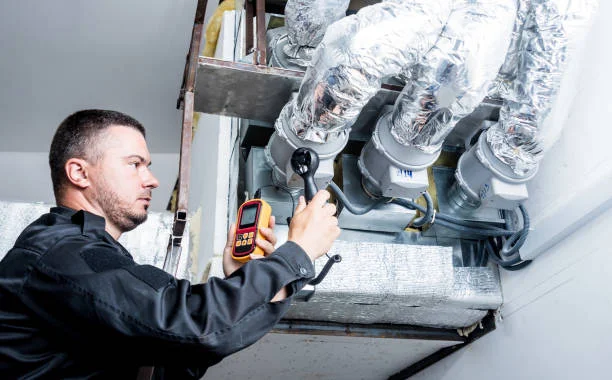Furnaces are an essential part of home comfort, especially during colder months, but they can pose serious risks if not properly maintained. Carbon monoxide (CO) is a colorless, odorless gas that can be produced by malfunctioning heating systems and is extremely dangerous if inhaled. Understanding how to inspect your furnace for potential carbon monoxide leaks is critical for maintaining a safe home environment. We will explore practical steps homeowners can take to identify early warning signs, conduct basic inspections, and implement safety measures to reduce the risk of CO exposure. Regular monitoring and proactive care can prevent health hazards while keeping your heating system running efficiently. Awareness and consistent checks are the first line of defense against this silent threat.
Loved this read? Explore more posts that expand your perspective now.
Steps to Inspect Your Furnace for Carbon Monoxide Leaks
Check for Physical Signs of Damage
Start by visually inspecting your furnace and its surrounding components, especially if you are considering furnace repair in Riverside. Look for rust, corrosion, or soot buildup around the heat exchanger and venting system. Cracks or holes in the heat exchanger can allow carbon monoxide to escape into your home. Examine the flue pipes to ensure they are securely connected and free of obstructions. Any damage to these components may indicate that the furnace is not safely venting combustion gases outside. Additionally, ensure the area around the furnace is clean and unobstructed, as debris can interfere with proper airflow. Identifying physical issues early can prevent small problems from becoming serious hazards and provide an opportunity to address them before carbon monoxide levels rise.
Install and Test Carbon Monoxide Detectors
A reliable CO detector is essential for any home with a gas or oil furnace. Install detectors near sleeping areas and on each floor to ensure comprehensive coverage throughout the entire building. These devices alert you to dangerous levels of carbon monoxide before it becomes life-threatening. Test your detectors regularly by pressing the test button and replacing batteries at least once a year. While detectors do not replace furnace inspections, they serve as a critical safety measure and provide peace of mind. Some models also feature digital displays that indicate the current CO concentration, allowing you to monitor trends and detect gradual leaks that may not be immediately apparent.
Observe Warning Signs During Operation
Pay attention to unusual furnace behavior that could indicate a CO leak. Yellow or flickering flames instead of a steady blue flame can signal incomplete combustion, a common source of carbon monoxide. Soot accumulation near the burner or around vents may also suggest inefficiency and possible gas leakage. Additionally, be alert to any unusual odors, such as a faint chemical smell, although carbon monoxide itself is odorless. Other indicators include frequent pilot light outages, increased condensation around windows, or unexplained health symptoms among household members, such as headaches, dizziness, nausea, or fatigue. Recognizing these signs early is crucial to preventing dangerous exposure.
Inspect Venting and Airflow Systems
Proper ventilation of combustion gases is crucial to furnace safety. Check the vent pipes, chimneys, and exhaust systems for blockages, leaks, or corrosion. Ensure all vent connections are tight and the pipes are properly sloped to allow gases to escape efficiently. Any obstruction, such as bird nests, leaves, or accumulated debris, can cause carbon monoxide to back up into the home. Verify that air intake vents are unobstructed and that combustion air is reaching the furnace correctly. Ensuring proper airflow not only reduces the risk of CO leaks but also improves furnace efficiency and extends the lifespan of your heating system.
Schedule Regular Maintenance and Professional Inspections
Even if your visual inspection and detectors indicate no issues, regular maintenance by a qualified HVAC service provider is crucial. Professionals can perform detailed checks using combustion analyzers to measure carbon monoxide levels in the furnace exhaust. They can also inspect the heat exchanger, burners, and venting system for hidden damage that may not be visible during a home inspection. While homeowners can perform basic checks, periodic professional inspections provide a thorough evaluation of the system’s safety and efficiency. Maintaining a service schedule helps prevent CO leaks, reduces repair costs, and ensures that your furnace operates reliably throughout the heating season.
Monitor Indoor Air Quality Continuously
Consider monitoring overall indoor air quality in addition to CO levels. Poor ventilation, high humidity, or the presence of other pollutants can exacerbate the effects of carbon monoxide exposure. Portable air quality monitors or smart home systems can provide ongoing feedback and alert you to potential hazards. Keeping your furnace area well-ventilated and ensuring the home receives fresh air helps minimize CO accumulation. Maintaining good indoor air quality also supports respiratory health and enhances comfort. By combining CO detection with general air quality awareness, homeowners can create a safer, healthier living environment.
Inspecting your furnace for carbon monoxide leaks is a vital responsibility for every homeowner. By observing physical signs, maintaining detectors, monitoring furnace operation, checking venting and airflow, and scheduling professional inspections, you can significantly reduce the risk of CO exposure. Awareness of warning signs, proactive monitoring, and immediate action when a leak is suspected are essential for keeping your home safe. Combining routine inspections with proper ventilation and air quality monitoring ensures that your heating system operates efficiently while protecting the health and well-being of everyone in your household. Taking these steps creates a secure and comfortable environment, free from the silent threat of carbon monoxide.
Don’t stop here — explore more stories that fuel your curiosity and mind.






